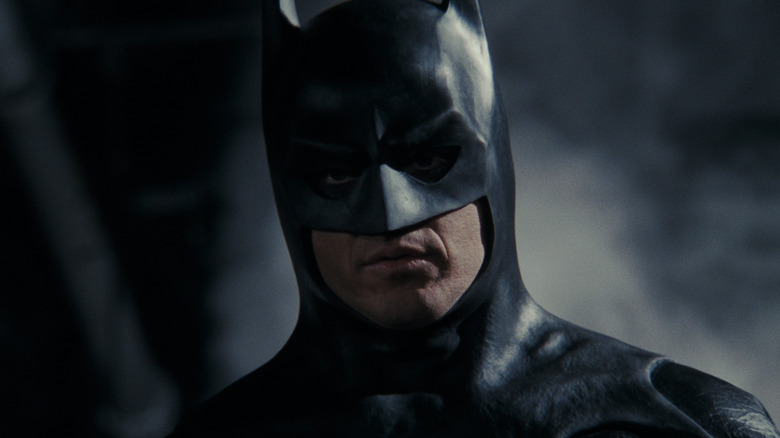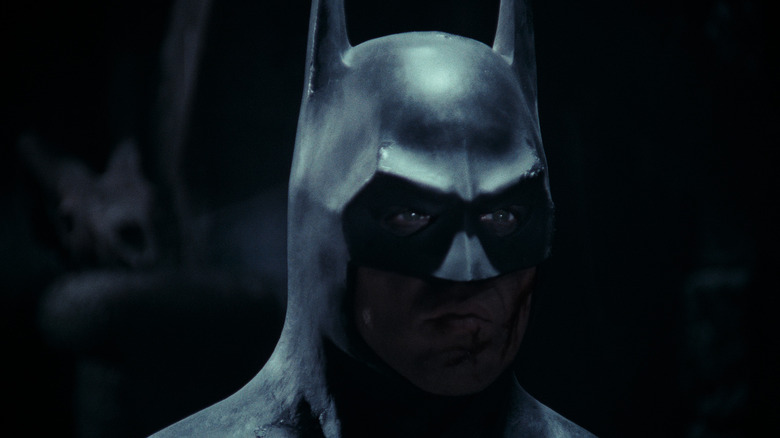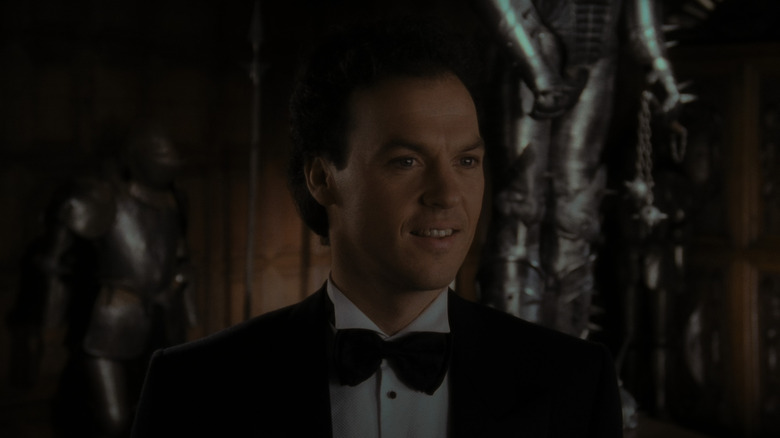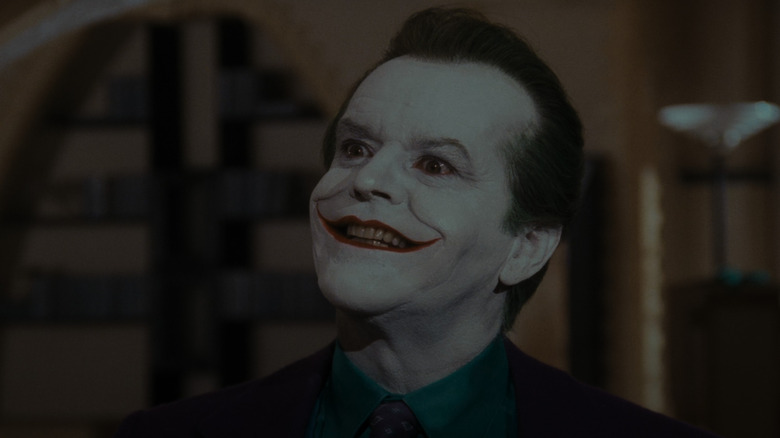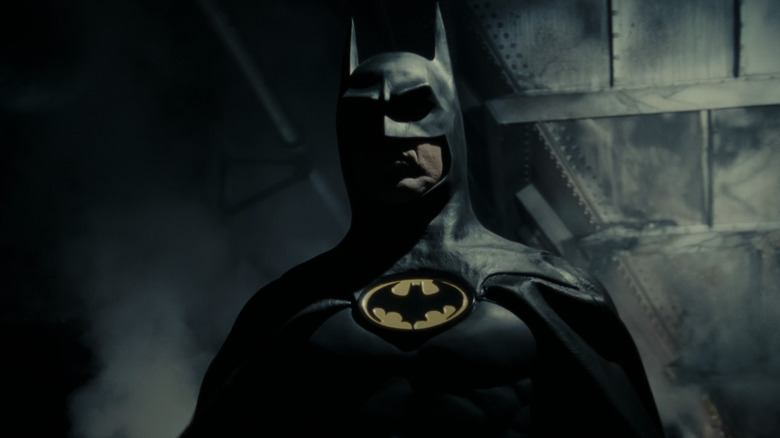Bringing His Vision Of Batman To Life Was 'Torture' For Tim Burton
In 2005, Christopher Nolan's "Batman Begins" introduced a darker and moodier version of the iconic superhero than had ever been seen on-screen before, and that angst and violence was further embraced by Matt Reeves' "The Batman" in 2022. For the first time in a while, moviegoers were given raw and brutal street fights between The Dark Knight and Gotham goons, and wanted more.
The overwhelming success of Nolan and Reeves' films proved that Batman fans longed for the tortured and barbaric version of the character after years of being dragged through goofy and childish portrayals of the vigilante in films such as 1966's "Batman," starring Adam West, and 1997's "Batman & Robin," starring George Clooney. Nolan's trilogy often receives credit, rightfully so, for tossing the grit and dirt back into the vigilante's image and tugging the film version of Batman closer to his graphic novel roots. However, Nolan wasn't the first movie director who created a feisty version of the character.
After the success of a strange little film called "Beetlejuice," Warner Brothers tapped Tim Burton to direct the biggest movie of his career so far, "Batman." Burton was already known for his quirky and strange films, and he planned to bring a uniquely gritty perspective to Batman, but getting that vision to the big screen wouldn't be an easy task. According to Burton in the 2016 book Hit and Run, creating the film was "torture" and "the worst period of [his] life."
'More than pow, zap, and wham'
The idea for 1989's "Batman" started when Executive Producer and lifelong comic fan Michael E. Uslan got a job at United Artists. In a "Making of 'Batman'" featurette of the film, Uslan admitted that he always wanted to see the dark and brooding version of the vigilante on screen and he felt like everything he'd seen had failed to do that:
"[Batman] had not ever quite been portrayed the way I thought Bob Kane and company really intended it to be. I really wanted to see that creature of the night emerge and let the world at large see that there is more to Batman than pow, zap, and wham."
Uslan pitched the idea to Hollywood producer Benjamin Melniker as a way to "reinvent the whole genre" of comic book movies by making it dark and serious. Melniker loved the idea, but it was turned down by all the major Hollywood studios. Ultimately, with the help of producer Peter Gruber, Uslan's idea was snagged by Warner Brothers, who had already experienced tremendous success with another superhero movie, 1978's "Superman." However, as Warner would quickly find out, the two characters have very little in common.
Although Uslan pitched the film as a realistic take on "Batman," the studio wasn't completely sold on that direction. In the featurette, Sam Hamm recalls Warner Brothers considering turning the movie into a period piece or a comedy starring Bill Murray as the vigilante and Eddie Murphy and Robin. Fortunately, those ideas were scrapped when Burton took on the project.
According to Hit and Run, Burton was excited to explore the darker side of the superhero, and he worked closely with Hamm, executive Bonnie Lee, and producer Roger Birnbaum for a year to get the script exactly how he wanted it. After a year of writing, the screenplay was greenlit by Warner Brothers.
Revising 'Wussman' and stressing Burton
Despite all the hard work Burton and Hamm had put into the script, and Warner Brother's giving it the thumbs up, the studio sided with producer Jon Peters when he suggested hefty rewrites. Hamm's original script featured what you'd expect of a Burton character, a weird, reclusive, and socially awkward guy. Reportedly, Peters referred to Burton's version of Batman as "Wussman," and called for a more stereotypical macho hero that he thought women would drool over.
Due to a strike by the Writers' Guild Of America, Hamm wasn't able to handle the rewrites, so Warren Skaaren came in to revise the screenplay. Surprisingly, Burton wasn't too bent out of shape by some of Peters' ideas. He told Hit and Run that he thought Peters was "creative" and that he had "some good ideas," but the director often felt overwhelmed by the size and budget of the project, and Peter's constant bullying of Burton and the crew didn't help. Peters recalled Burton even running off the set in tears after he told him the movie needed more "pathos and romance."
The tyrannical producer wasn't the only issue Burton had to deal with either. The film's budget continued to increase, which deepened Warner Brothers' fears about how audiences would receive the film. "Pretty much every day the studios were saying, 'It's too dark, it's too dark,'" he told The AV Club in a 2022 interview. On top of that pressure, Sean Young, the actress originally cast as Vicki Vale, fell and broke her arm shortly after filming began, leading to her replacement by Kim Bassinger. This was a small adjustment until the actress became romantically involved with Peters. Their entanglement would cause even more stress for an already stressed and overwhelmed Tim Burton.
The controversial ending
Hamm's original ending included a classic showdown between Batman and The Joker (Jack Nicholson) on the top of a cathedral. However, at the last minute, Peters decided that new girlfriend, Bassinger, should be a part of the scene and that the production should dish out $100,000 to build a completely unnecessary 38 foot model of a cathedral bell tower. To add insult to injury, Peters did it all behind Burton's back, but the director would be the one to deal with the aftermath of Peter's rash decisions.
Now, instead of a battle between the dark knight and his arch nemesis, "Batman" was going to end with The Joker leading Vicki Vale up some rickety stairs to the belltower so he can ... catch a ride on a helicopter? Nothing about that makes sense, but I guess a nonsensical ending is better than dropping $100,000 on a set that isn't used in the movie. The ridiculousness of the scene didn't escape the notice of the film's stars either. Burton recalled being stumped when asked about the reasoning behind the odd set piece:
"Here were Jack Nicholson and Kim Bassinger walking up this cathedral, and halfway up Jack turns round and says, 'Why am I walking up these stairs? Where am I going?' And I had to tell him that I didn't know."
Despite the hastily reworked and illogical ending, "Batman" grossed a whopping $251 million dollars, and remains the 5th most lucrative film about the Caped Crusader ever. And as Uslan predicted, the movie forever altered the superhero genre.
The Legacy of 'Batman'
Prior to Burton's "Batman," films about superheroes were full of righteous heroes, tight spandex, bad puns, and weak villains. Burton's superhero wasn't afraid to wallow in self-pity over his childhood trauma, and even exact a little revenge when the opportunity presented itself, which are two things Adam West definitely would have objected to. Nicholson's Joker is far more than a quirky guy in a purple suit with a bad dye job. He's a stone-cold murderer who forces himself on women and lives for violence.
Burton revolutionized both the superhero and villain, but he also changed world-building expectations in comic book films. Earlier versions of Gotham City featured seaside views and psychedelic colored sets, but Burton's Gotham has a dark, steampunk aesthetic that gives Gotham a gritty edge, and hints at the city's corrosive crime that first inspired Bruce Wayne's vigilante persona. It also helps audiences see the superhero's city as part of a vast and wide world that feels real and almost tangible.
I'd never speak ill of Nolan or Reeves' accomplishments with Batman because they both deserve every bit of praise that's thrown their way, but I think it's only fair that Tim Burton gets a little more recognition for his contributions, too.
